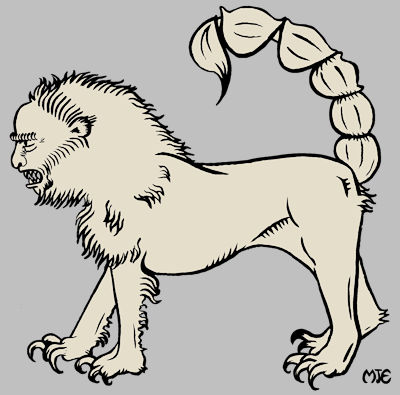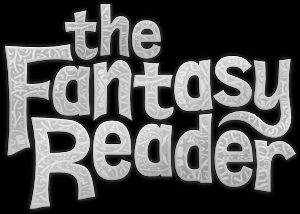The Manticore

‘What be these mantichores of the mountains that eat men’s brains?’
So asks Lady Mevrian in E R Eddison’s wonderful 1922 fantasy, The Worm Ouroboros. Her brother, the Demonland warrior Brandoch Daha, provides the answer thanks to a book he’s browsing:
‘This book is so excellent well writ,’ said her brother, ‘that thine answer appeareth on this same page: “The beeste Mantichora, whych is as muche as to saye devorer of Menne, rennith as I herde tell, on the skirt of the mowntaynes below the snow feldes. These be monstrous bestes, ghastlie and ful of horrour, enemies to mankinde, of a red coloure, with ij rowes of huge grete tethe in their mouthes. It hath the head of a man, his eyen like a ghoot, and the bodie of a lyon lancing owt sharpe prickles fro behinde. And hys tayl is the tail of a scorpioun. And is more delyverer to goo than is fowle to flee. And hys voys is as the roaryng of x lyons.”’
The earliest known description of ‘the beeste Mantichora’ occurs in the writing of the Greek Ctesias (who lived in the 5th century BCE), in his book on India. Although this is now lost, a later writer, Pausanias, refers to it:
‘The beast described by Ctesias in his Indian history, which he says is called martichoras by the Indians and ‘man-eater’ by the Greeks, I am inclined to think is the tiger. But that it has three rows of teeth along each jaw and spikes at the tip of its tail with which it defends itself at close quarters, while it hurls them like an archer’s arrows at more distant enemies; all this is, I think, a false story that the Indians pass on from one to another owing to their excessive dread of the beast.’
Other writers mention the manticore’s musical voice, likening it to a trumpet or pipes, which lures men to their deaths with its apparent beauty.
Like the myth of the beast itself, the name ‘manticore’ comes into English through a circuitous, mutating route. Originally a Persian word meaning ‘man-eater’, it was translated into Ancient Greek, mis-transcribed, translated into Latin, and then came into English as ‘manticore’, which led some later writers to think it a melding of the words ‘man’ and ‘tiger’.
It was probably a lion or a tiger. I mean, wasn’t it? But, on the way from lion (or lyon) to manticore back to lion again, it left us the mythical beast and heraldic symbol, like a gift from the ancient imagination.
Having heard Brandoch Daha read the description of this mythical beast, another of E R Eddison’s Demonland warriors says:
‘These beasts… were alone enough to draw me thither. I shall bring thee home a small one, madam, to keep chained in the court.’
Whereupon the cool, elegant Lady Mevrian replies:
‘That should dash me from thy friendship for ever, cousin,’ said Mevrian, stroking the feathery ears of her little marmoset that cuddled in her lap. ‘That which feedeth on brains were overnourished in Demonland, and belike would overrun the whole country-side.’
Sources
- Manticore — Wikipedia
- The Worm Ouroboros by E R Eddison, chapter 8 — Sacred Texts
- Manticore — The Medieval Bestiary
